
|
Note ye ed's email address: stevebryant99@gmail.com. Finally unearthed: The Little Egypt Book of Ghosts from H&R Magic Books. |

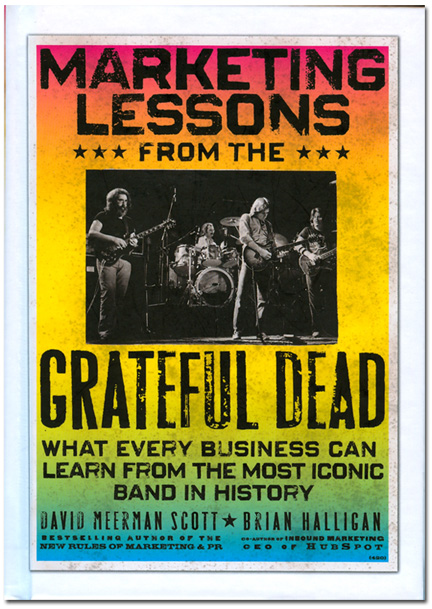
Advice from the Dead.
|
August 2010 Wow. When August began, I thought I would find nothing of interest to chat about, mere crumbs from the dog days of a lost summer. Somehow the month has turned into a full plate. I am leading off with a book from the real world, one that can possibly make you successful beyond your wildest dreams. This book on Grateful Dead business ideas, however unlikely those words seem together, is very important. Also up, a look at a most enjoyable 54th Midwest Magic Jubilee, John Guastaferro's new card book, One Degree, Ron Wilson's Tales from the Uncanny Scot, an issue from The Little Egypt Gazette put to rest at last, and a look at big things coming from Genii. As to the tardiness of this issue, blame Mr. Guastaferro. It took me a while to work through his amazing card tricks. |
|
|
DEAD-ON BUSINESS TIPS -- Prominently displayed in such stores as Borders and Barnes and Noble is a new book of not-so-common-sense business wisdom, Marketing Lessons from the Grateful Dead, by David Meerman Scott and Brian Halligan. The authors explore how the Dead rewrote the rules of their profession and prospered wildly, and I've never read business advice more applicable to magicians and other performers. The nineteen chapters in this compact volume will teach you how to rise above the herd and love doing it. Consider chapter one: Create a Unique Business Model. The Dead did so by making concert tours their main source of income when other bands were doing only occasional concerts to make record companies rich. Same product -- music -- but a different way of marketing it. Other examples cited: Netflix vs. Blockbuster, eBay vs. garage sales. Consider magic, and I find David Blaine the most obvious example. Same product -- standard close-up tricks -- but what a different way to market them. Instead of doing them table to table at Denney's for tips, why not do them on a prime time television special shot like an episode of "Cops"? Brilliant. With very little effort, you'll see how other top magicians have reached the top by following the counter intuitive wisdom laid out. (Tempting to do so here, but I don't want to reveal too much of the book.) It's a very exciting read and possibly the most important book ever written on how to be successful in magic. And no, you don't have to be a Deadhead to "get" it. Hardback, 166 pages, $21.95, at book stores everywhere. |
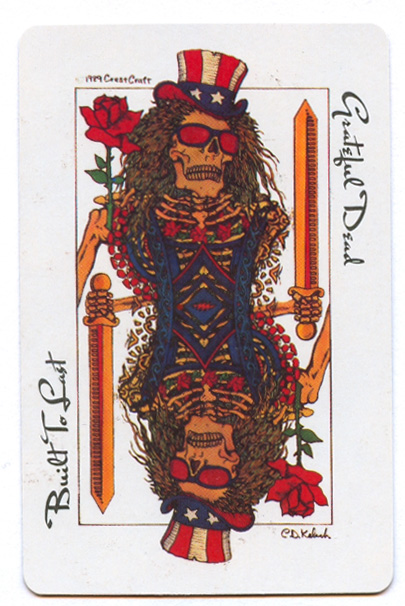 Back design from a favorite deck. |
|
|
I WILL BE YOUR TOOTSIE WOOTSIE, IF YOU WILL MEET ME IN ST. LOUIS, LOUIS -- (Sorry, my mom loved that song.) Local conventions have a charm that often eludes the more heavily populated nationals. A recent return visit to St. Louis, for the 54th annual Midwest Magic Jubilee, gave me the opportunity to hobnob with some fascinating local professors as well as some of the movers and shakers of the convention. Fond memories include watching Howie Schwartzman, Kozmo, and Keith Fields doing turns on a handy piano; listening to 99-year-old youngster and convention honoree John Calvert tell me about his winning an automobile race in Shelbyville, Indiana; laughing at Tom Burgoon's hilarious stage and dealer room routines (I loved the Sex Detector and Snake Eyes); looking over Kozmo's shoulder as he proofed his latest reel magic issue featuring Kostya Kimlat; witnessing Michael Long's Clock trick; cracking up (guiltily, because it was so dumb) at Chase Goforth's Stick Horse routine; admiring, in awe, the elegant magic of Michael Lair, Eric Jones, and Losander; losing count as Chris Smith destroyed more light bulbs than Marvyn Roy ever lit up; feeling privileged to watch Howie do a formal close-up set and laughing at his schtick with his new bride (Q: Do you cheat on your wife? A: Who else?); and enjoying Keith Fields' book tests, his Chop Cup routine, and his U.S.-British language issues. 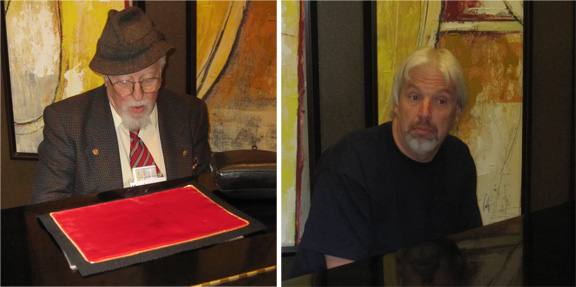 Dueling pianos. A few special highlights: Barrie Richardson's lecture included such visual treats as a production of a large glass of water from his jacket (as he removed it) and a water suspension. Barrie was thoroughly professorial, and I particularly enjoyed his gambit for taking the sting out of any Bank Night effect. Word is that Barrie has a third book in the works at Hermetic Press. 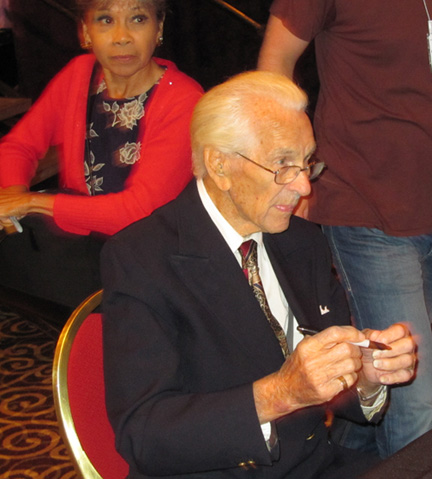 A signature moment. Nathan Kranzo makes me laugh, but I also enjoyed the magical aspects of Crackers (he appears to be eating money), a Binaca spray routine in which he produces an ice cube from his cold breath, and a Card from Zipper routine that utilizes a Mene Tekel deck. I just noted that Nathan has a full Mene Tekel DVD available, an overdue resource on this underutilized gaffus. Scott Wells gave terrific and thoughtful performances as emcee of the big show and as host of a late-night panel discussion (he also presented a late-late lecture which I had to forego). His emcee work included clever production value introductions of the acts, some ideas of which he discusses in his fine lecture notes, Alternate Streams of Revenue in Magic. But it was the informal moments with Scott that made the visit, his discussion of some of the spooky magic he is working on. Check out houstonseance.com for a look into the dark side of Scott Wells. David Acer, who does straight comedy for a living, was the funniest act of the convention. He taught some fine magic in his lecture (cell phone from envelope and my long-time favorite, Ghost in the Machine, come to mind), but it was his sham mentalism that I'll remember most. I'd love to steal his bit on remote viewing. Now, if I could just throw up a block to prevent him from seeing that ... Joshua Jay was the draw for my attending this convention. A busy lad, Josh had three tv interviews on Saturday morning to plug his latest bestseller. Elsewise, he presented a great lecture (loved his Transporter, a sort of Trojan Horse card gimmick), performed a strong multiple selection routine for his Close-Up appearance (no wussy popout moves), and spent what time he could at his dealer booth, demonstrating great magic from Vanishing Inc.'s new John Guastaferro book (reviewed elsewhere in this issue). But my favorite Josh Jay moment was his stint on the late-night panel discussion, where he talked about his initial and his triumphant appearances with Kathie Lee on "Today." Very funny stuff. With 59 countries under his belt as a student and teacher of magic, Josh may be the closest thing we have to a modern Dai Vernon in terms of his passion for the field. 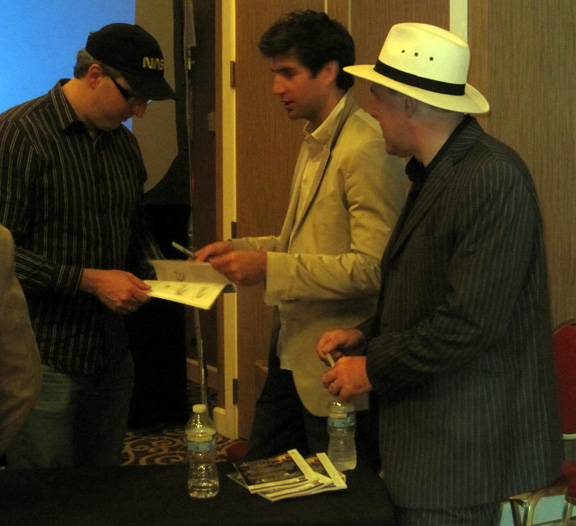 David Acer, Joshua Jay, and Keith Fields convene beneath the Arch. All in all a delightful weekend, give or take a fire drill or two. It was refreshing to see the big names attending and enjoying the shows and lectures of others. My only complaint, a pet peeve of this and other conventions (I'm not blaming St. Louis for this): magicians who sit or stand at the back of shows or lectures and TALK, showing each other card tricks or whatever. Here's a bit of news: we can HEAR you. There is always a lobby or coffee shop, guys. Use it! Have a little respect for your fellow performers/lecturers. |
|
|
Despite cutbacks in book publishing, especially with a rise in e-books, wonderful books still appear in the marketplace, at a rate faster than my pile of loot and time to read can accommodate. Here are two highly valued recent acquisitions. | |
|
THE NTH DEGREE -- Somewhere in Steve Martin's Born Standing Up he lays out his key to success: "Be so good they can't ignore you." When I picked up John Guastaferro's new card book, One Degree, I figured that I barely had time this month to skim through the book and hopefully find a few card tricks strong enough to recommend. (I was predisposed to like the book, because I had seen Guastaferro perform at MAGIC Live, and because Vanishing Inc., the publisher, has a nice track record.) Alas, Guastaferro must have evolved under the Martin philosophy, because all the tricks were so good that I couldn't ignore them. I had to work through each one, cards in hand, to fully appreciate this special material. Even if all the tricks don't make it into your working repertoire, they are going to make it to the first callback. |
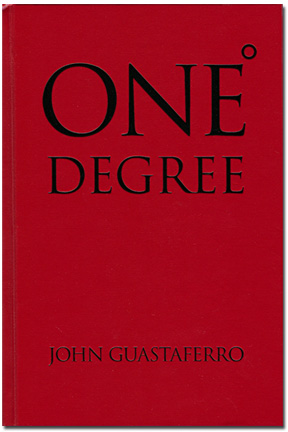 Small touches with big results. |
|
A few favorites: Either Or: A very sneaky no-sleight method of culling four or five cards. Palm Reader Plus: A card is chosen (QH). The four aces then become all AH in sympathy, and then transform into all four queens. Makes great use of Bannon's Discrepancy City Display. Intro-verted: This is the one Josh was demonstrating. It's a four card discovery (either selections or aces, for ex.) featuring Inversion among its elements. Amazingly, it can be done to set up a color changing deck routine. Check it out at johnGmagic.com. 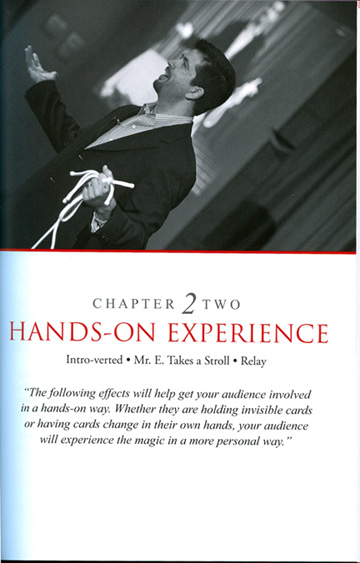 Looking good. Mr. E Takes a Stroll: My favorite of the lot; I've been doing it. A sort of four ace discovery combined with Hamman's Signed Card. Great fun to perform. Behind the Back Triumph: A new plot in that the spec makes random cuts (you don't even know how many) that unscramble a shuffled deck. Almost like real magic. Vino Aces: A parlor/stage version of McDonald's Aces. You'll love the methods and clean handlings of these routines. There is also a handful of interesting essays whose advice I will use, certainly not the usual rehash one finds in some books. This is a lovely book slightly over 6 by 9 inches, 153 pages, strikingly laid out in two colors. I've been studying design lately, and this design is first rate. $50 from Vanishing Inc. Visit the web site for a video introduction and a complete table of contents. RON WILSON TELLS TALES -- One of the favorite books in my library is The Uncanny Scot, by Richard Kaufman, featuring the remarkable magic of Ron Wilson. I had the good fortune to hang about the Magic Castle when Ron was in his prime, and I enjoyed his close-up and his stand-up acts many times. New to the streets is Tales from the Uncanny Scot, by Ron himself. In its 196 pages are hundreds of photos and dozens of reminiscences of Ron's friends, everyone from Cary Grant to Bobby Fisher, with plenty of magicians and movie stars in the mix. It's a marvelous informal history of the (first) golden age of the Magic Castle. Also included, equally delightful, is a DVD containing interviews with Ron by Nick Lewin and R. Paul Wilson (Paul also performs and teaches The Highland Hop) along with Ron's complete Magic Castle stage act. Hardback, nicely produced with Steve Mitchell, a steal at $45 directly from uncannyscot.com. 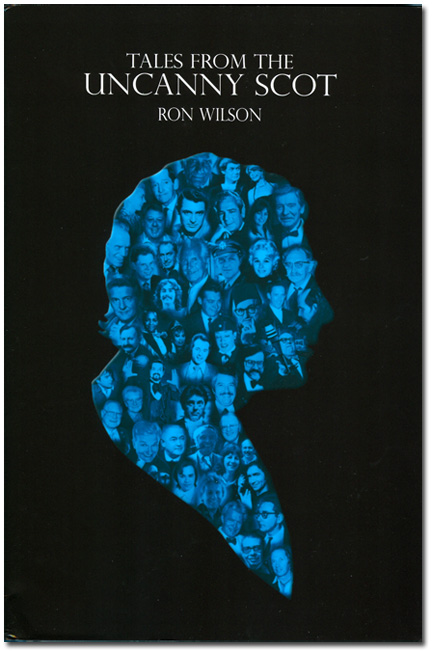 Ron Wilson looks back. | |
|
|
BACK TO THE LITTLE EGYPT GAZETTE -- Way back in the September 1997 "British" issue of The Little Egypt Gazette (worth your while for tricks by and interviews with Simon Lovell and Peter Duffie), we ran the following piece in the "Stirring the Tana Leaves" section:
At last, however, I did invent a trick that looked as if it might have worked had I been able to make the necessary apparatus, which included an imitation of the little vest-pocket Kodaks then in vogue. I wrote it all out with diagrams and sent it to The Magician Monthly, a magazine I read with fascinated interest every time the mail brought it to Thika. To my great surprise, and even greater gratification, they published the trick in their section devoted to New Magical Suggestions and, in lieu of a fee, gave me credit for two guineas at Will Goldstone's. I spent many delectable hours laying out this sum to the best advantage from the catalogue.
* * *
A final note. One of my stringers, in Chicago, is trying to track down the original Elspeth Grant Huxley submission to The Magician Monthly. I have faith in his prowess in these matters, and will pass the item along in these pages upon a successful conclusion to his research. My so-called "stringer" was Jay Marshall, who had access to the Lund collection, at that time the only source I knew that might harbor the required issue of The Magician Monthly. Alas, Jay never managed to satisfy my curiosity as to young Miss Grant's magical creation. Fast forward to last month's Essential Magic Conference, specifically to Bill Kalush's talk on his Conjuring Arts Research Center. In a terrific act of generosity, Bill granted attendees thirty-day access to his research tools. Although my initial forays produced no results (Elspeth listed her name as E. Grant, no doubt to conceal her gender, and her discussions of the conjurer used the masculine pronoun), the word Kodak struck paydirt. Suddenly, there in the September 1923 issue of The Magician Monthly lay this marvelous magic trick, a complex bit of mechanical engineering and magical subtleties that Elspeth called "Magical Photography -- A Trick with a Phenomenal Camera."  Did Goldstone know she was a girl? The trick begins with twenty or so flags, of various nations, being placed in a borrowed hat. The hat is covered with a white handkerchief, and any spectator is allowed to reach in and withdraw a flag at random. Secretly, the handkerchief concealed a batch of identical flags, one of which would of course be forced. Elspeth justified this "fair" procedure by arguing that "certain unkind people would probably say that I had a confederate among the audience" had someone been allowed to merely name a flag. The spectators then seal the selected flag inside an envelope, a handkerchief, and a box. To presumably identify the flag, the magician then introduces a common Kodak camera, but one "with peculiar x-ray qualities." (I love this bit of patter!) The magician then claims he will take a snapshot not of the box, but of the flag inside it. And the magic begins. With no cover, the camera suddenly morphs into the roll of film that had presumably been inside it. The detailed engineering (dimensions are given to 1/10 in.) involves what appears to be a common Vest Pocket Kodak, but which is really a gaffed-to-the-hilt contraption involving flesh-colored elastic and hinges that allow the device to swing around and be hidden in a sort of backpalmed condition, revealing only a roll of film remaining in the hand. Elspeth thought to have the back and sides of the camera flesh colored as well so that any leakage between the fingers would not show. The second piece of magic is that the roll of film visibly becomes the flag itself, and the box, handkerchief, and envelope that previously contained it prove empty. The roll of film is a hollow chamber that contains a duplicate flag, and the roll itself vanishes via a pull. The empty envelope had been accomplished well ahead of the game by an envelope switch. As Elspeth wraps up the description of the performance, she says, "The trick is now over, and the discovery of the envelope being empty depends entirely on showmanship." Although she apparently never constructed the device or performed the effect, her attention to detail and consideration of performance issues were admirable. This "dabbler both in magic and photography," as she characterized herself, was also quite the dabbler in writing, and it was there that she would soon make her mark in life. What fun it was for me to finally lay eyes on this material. Huge thanks to Bill Kalush for giving the EMC attendees temporary access, and I can think of fewer more rewarding investments than to subscribe to one of the various levels of the Conjuring Arts Research Center. Part of your subscription is tax deductible. It's like doing research deep in the stacks of some prestigious university library, but you never have to leave your bedroom. How cool is that? | |
|
THE iGENII -- One of the pieces of advice in the Grateful Dead book above is to free your content. (The Dead encouraged fans to photograph and record their concerts. The result -- more attendance and more album sales!) Richard Kaufman is about to do this in a big way with Genii, and I think it is going to be huge for him. Subscribers are about to receive access to all past issues of Genii, 70 years of superb material and coverage. This is part of a deal Richard has worked out with the Conjuring Arts Research Center. You'll have access to pdf files of all of "The Vernon Touch," all of Charlie Miller's "Magicana," all of Paul Osborne's illusions, and on and on. You could read forever. Meanwhile, through some fantastic new software I've never seen before, Richard is making certain special issues of Genii, such as the Steranko card issue, available in an even more exotic, full-page format. Visit the Genii web site and have fun. And if you haven't already, subscribe! 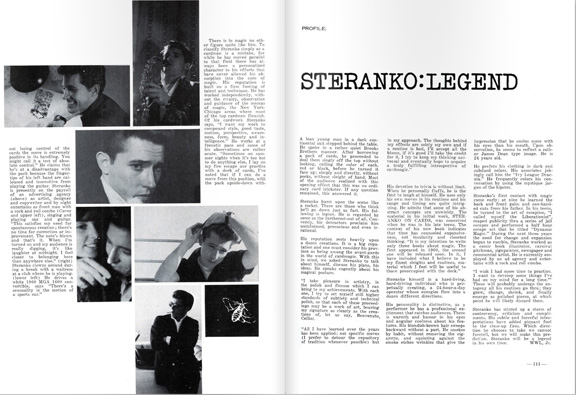 Possibly the best issue of Genii ever -- free! |
|
Answer to quiz: 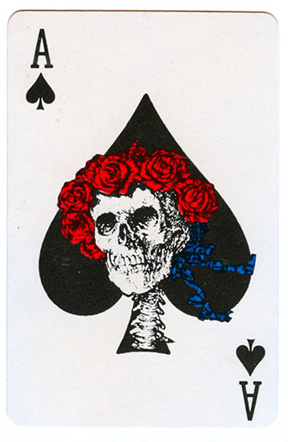 The ace of spades.
Halloween is coming. Do you know where your copy of The Little Egypt Book of Ghosts is?
Sarah and Simon (Vixen and Spike to old Gazette readers) were married on April 1, 2006. You may access their wedding photos at wedding photos. Little Egypt Magic is the erratically updated web site of Steve Bryant, spawned (the site, not Steve) by a former internet magazine known as The Little Egypt Gazette/for magicians only. Steve Bryant is an obscure magician and writer who generates this site from an iMac in Bloomington, Indiana. He frequently journeys to and performs magic in Little Egypt, the local name for extreme southern Illinois, where the towns bear such names as Cairo, Thebes, and Karnak. Past issues of this web site: Index to Past Issues |
A JSB Creations product
Copyright© 2010 by Steve Bryant